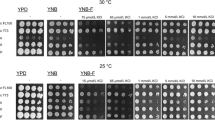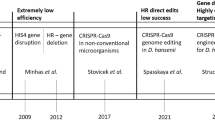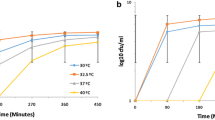Abstract
The osmotolerant yeastPichia sorbitophila was found to differ from other yeast species, not only from the conventional ones (Saccharomyces cerevisiae, Schizosaccharomyces pombe), but also from those widely known as osmotolerant (Debaryomyces hansenii, Zygosaccharomyces rouxii).P. sorbitophila was able to survive extremely high extracellular concentrations of salts (e.g., saturated solution of KCl) and other osmolytes (70 % glucitol), although it is not classified as halophilic (or osmophilic).P. sorbitophila assimilated a broad range of carbon and nitrogen sources with extreme effectiveness. On solid media,P. sorbitophila created colonies of variable shapes and sizes in relation to media composition, number of colonies on the plate and cultivation conditions. Colonies were able to produce long-distance signals between each other that resulted in growth inhibition of the facing parts of both colonies, but were not inhibited by colonies of other yeast species growing on the same plate. Though sometimesP. sorbitophila has been indicated as a synonym ofP. farinosa, comparative physiological studies together with PCR amplification ofP. farinosa DNA fragments homologous to knownP. sorbitophila genes provided a strong indication that this strain should be classified as a separate species.
Similar content being viewed by others
References
Bleykasten-Grosshans C., Prior C., Potier S.: Cloning and sequence of theLYS2 homologue gene from the osmotolerant yeastPichia sorbitophila.Yeast 18, 61–67 (2001).
Bon E., Neuveglise C., Casaregola S., Artiguenave F., Wincker P., Aigle M., Durrens P.: Genomic exploration of the hemiascomycetous yeasts — 5.Saccharomyces bayanus var.uvarum.FEBS Lett. 487, 37–41 (2000).
Dichtl B., Stevens A., Tollervey D.: Lithium toxicity in yeast is due to the inhibition of RNA processing enzymes.EMBO J. 16, 7184–7195 (1997).
Hoffman C.S., Winston F.: A 10-minute DNA preparation from yeast efficiently releases autonomous plasmids for transformation ofEscherichia coli.Gene 57, 267–272 (1987).
Kurtzman C.P., Fell J.W.:The Yeasts, a Taxonomic Study. Elsevier, New York 1998.
Lages F., Lucas C.: Characterization of a glycerol/H+ symport in the halotolerant yeastPichia sorbitophila.Yeast 11, 111–119 (1995).
Lages F., Silva-Graca M., Lucas C.: Active glycerol uptake is a mechanism underlying halotolerance in yeasts: a study of 42 species.Microbiology 145, 2577–2585 (1999).
de Miranda L.R., Appel K.R., Seyfarth H.:Pichia sorbitophila sp.nov.Antonie van Leeuwenhoek 46, 157–159 (1980).
de Montigny J., Spehner C., Souciet J., Tekaia F., Dujon B., Wincker P., Artiguenave F., Potier S.: Genomic exploration of the hemiascomycetous yeasts — 15.Pichia sorbitophila. FEBS Lett. 487, 87–90 (2000).
Oliveira R.P., Lages F., Lucas C.: Isolation and characterization of mutants from the halotolerant yeastPichia sorbitophila defective in H+/glycerol symport activity.FEMS Microbiol.Lett. 142, 147–153 (1996).
Palková Z., Forstová J.: Yeast colonies synchronise their growth and development.J.Cell Sci. 113, 1923–1928 (2000).
Palkova Z., Janderova B., Gabriel J., Zikanova B., Pospíšek M., Forstová J.: Ammonia mediates communication between yeast colonies.Nature 390, 532–536 (1997).
Prista C., Almagro A., Loureiro-Dias M.C., Ramos J.: Physiological basis for the high salt tolerance ofDebaryomyces hansenii.Appl.Environ.Microbiol. 63, 4005–4009 (1997).
Sychrova H., Braun V., Potier S., Souciet J.L.: Organization of specific genomic regions ofZygosaccharomyces rouxii andPichia sorbitophila: comparison withSaccharomyces cerevisiae.Yeast 16, 1377–1385 (2000).
Author information
Authors and Affiliations
Corresponding author
Rights and permissions
About this article
Cite this article
Marešová, L., Sychrová, H. Physiological characterization of osmotolerant yeastPichia sorbitophila and comparison with a putative synonymPichia farinosa . Folia Microbiol 48, 211–217 (2003). https://doi.org/10.1007/BF02930958
Received:
Issue Date:
DOI: https://doi.org/10.1007/BF02930958




